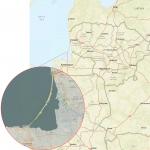Blue Lake, in Nelson Lakes National Park on New Zealand's North Island, is considered the cleanest lake on Earth. According to measurements, underwater visibility in the reservoir ranges from 73 to 80 meters!
![]()
It’s wonderful, but only specialists can see it from the inside. Everyone else, with a certain persistence, can admire the Blue Lake only from the outside - swimming is prohibited here, since the local indigenous population from the Maori tribe considers the reservoir sacred.
The original name sounds like Rotomairewhenua, translated as “lake of peaceful lands” and makes you think very much, since the Maori have always been a warlike people, and let’s keep silent about cannibalism.
- By the way, the crystal clearness of the reservoir is explained simply. The lake is filled with water from the neighboring much larger Lake Constance (not to be confused with the German Lake Constance))), and before it gets where it needs to go, it passes through a mountain range, clearing itself of impurities and suspended matter.
![]()
Relatively close (even further north) is another famous landmark of New Zealand, the volcanic lake Rotorua, which occupies the crater of an ancient volcano.
As is known, due to its remoteness and unspoilt beauty, it is now considered one of the exclusive tourist destinations and is popular among wealthy or established travelers. It’s not expensive, but it’s so beautiful!
In previous posts on the topic - lakes of the world, we introduced you to floating islands and amazing flowers. Today we offer you to travel to New Zealand, to an unusual lake on the planet - Rotomairewhenua, which translated from Maori means blue Lake. This small freshwater lake is located in the Nelson Lakes National Park, in the northern regions of the Southern Alps, New Zealand.
It has become famous since 2011, when specialists from the National Institute of Water Resources and Atmospheric Research discovered that the lake has extreme visibility, the visibility of which reaches 80 meters in depth. Previously, the world record was held by another lake - Te Waikoropupu Springs, which is also located in New Zealand and which has a visibility of 63 meters.


Blue Lake is characterized by blue-violet hues, which are caused by natural filters that purify the water. The lake is fed by a glacial reservoir located in the mountains. The dam between them, consisting of different rocks, is an excellent natural filter.

 The first person to spark interest in the small lake was hydrologist Rob Merriles. Then the specialists from the National Institute came into play, led by Dr. Rob Davis-Colley. Six scientific flights to the blue lake confirmed that its waters are crystal clear. “The theory is that visibility in distilled water is about 80 meters, and this is the best measurement estimate,” says Rob Davies-Colley. “Blue Lake comes close to such estimates.”
The first person to spark interest in the small lake was hydrologist Rob Merriles. Then the specialists from the National Institute came into play, led by Dr. Rob Davis-Colley. Six scientific flights to the blue lake confirmed that its waters are crystal clear. “The theory is that visibility in distilled water is about 80 meters, and this is the best measurement estimate,” says Rob Davies-Colley. “Blue Lake comes close to such estimates.”



New Zealand's Tongariro National Park is located Emerald Lake Sa Morakot. It is famous for the extraordinary color of its water, changing depending on the lighting and time of day from pale blue to emerald green.

Thanks to underground hot springs, the lake water is highly mineralized and very warm. The reason for Sa Morakot's unusual color is the high concentration of minerals in the water.


From highways Emerald Lake located at some distance. You can get to it on foot, passing through a one and a half kilometer clearing or along a path. This road is much longer, but very picturesque and much more interesting than the first. It leads through mangroves and tropical rainforest.


Emerald Lake It has the shape of a lens, which is why it seems quite shallow, despite its three-meter depth. Its size is no more than ten meters in diameter. The reservoir is formed by underground springs, bringing from the depths of the earth many minerals containing copper sulfate. This explains the blue tint at the bottom of the lake. If you look closely, you can see the springs that feed Sa Morakot in the clear water. The water of the sources is warmer than the temperature at the surface of the reservoir. For this reason, an interesting effect is created, as if in hot weather from asphalt heated up during the day.


Emerald Lake- a real miracle of nature. The place is so peaceful that it is a pleasure to just sit there, listen to the sounds of the forest and admire the beauty of the lake.
Within the borders of the very southwest, the region has one interesting lake called Houroko. The lake is not large, its area is 63 square kilometers. Nearby are lakes Monowai and Poteriteri, and Houroko lies between these lakes. And a little further away is the country's southernmost lake, Hakapaua. A few kilometers south of Lake Houroko rises Mount Caroline Peak, whose height is 1704 meters. From the lake to the largest fjord there are only 18 kilometers, but this road is very difficult and impassable. Houroko lies in a remote area and there is no bus service there. There is only one road leading to the lake, which leads to road number 99 in the Clifden area. The section of this road, approximately 10 kilometers from the lake, is of poor quality. There is no asphalt surface here, the road is strewn with fine gravel, but it is quite flat. The rest of the road is in very good condition. The closest settlement is a small town, about 35 kilometers east of the lake.
The deepest lake in the country.
The main reason for interest in Lake Houroko is not only its beauty. This lake is the deepest lake in the world and ranks seventeenth in the list of the deepest lakes in the world. Its depth is 462 meters. When you imagine that under your boat there is a layer of water almost half a kilometer deep, you can’t help but tremble. Houroko is also one of the southernmost lakes in the world. Lake Houroko stretches from north to south and is very long, but narrow. If you sail on a boat on the lake, you get the impression that you are floating on a river. Its length from north to south is 40 kilometers, and its width does not exceed three kilometers. Even on a speedboat it takes at least an hour to cross the length of the lake. If you look at the lake from a bird's eye view, the lake resembles the Latin letter "s". The water in the lake is very clean and cold, probably due to its depth and alpine location, since it is located at an altitude of 150 meters above sea level. Lake Houroko has a connection with the ocean. In the southernmost part of the lake, the Wairaurahiri River flows out of it, which carries the waters of the lake into the ocean. The distance from the shores of the lake to the shores of the ocean is 20 kilometers.
Tourism.
The lake is not yet an object of tourist pilgrimage. There are no hotels, motels or restaurants here. There is no tourist infrastructure in the lake area. Nearby hotels and restaurants are located in and the distance to which is from eighty to one hundred kilometers. There is, however, a small hotel in the town of Tuataper, but the town is not a tourist site and therefore there are no proper conditions here, although you can spend another night. The hotel has a refrigerator, hot water, internet and all other necessary conditions. The route of one of the most difficult tourist routes, the Dusky Trek, whose length is 68 kilometers, passes through the lake. You don’t often see people on the lake; sometimes local farmers come to relax, mostly on weekends. But you can do good fishing on the lake.
Damn island.
Mary Island is located in the eastern part of Lake Houroko. This is the largest of all the islands in the lake. Many local myths are associated with this island. They say that this island was cursed by Maori sorcerers. Whether this is true or not, we don’t know about it. Local Maori deny this fact. The lake and the island did not cause any harm to people. Let's hope that the stories about the cursed island are myths and legends, folklore. But be that as it may, in order to avoid troubles, it is better to admire the island from the outside, otherwise who knows, anything can happen.
Lake Houroki is very beautiful. Uninhabited area, snowy mountain peaks surrounding the lake on all sides and nature untouched by human hands. All this creates unforgettable impressions, and the memories remain in our memory for a lifetime.


